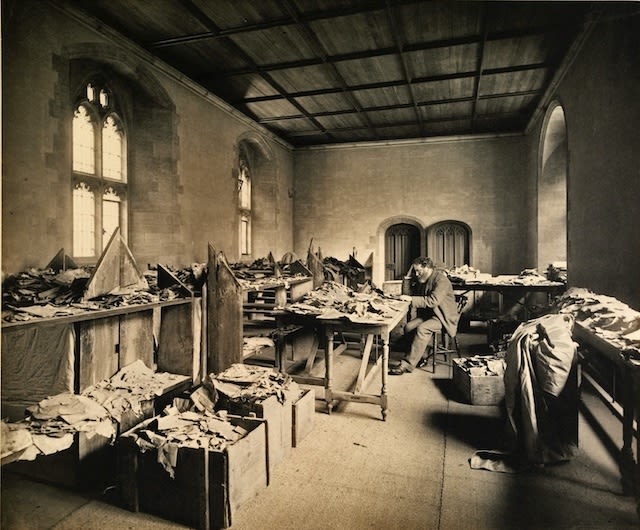We will never fully know what life was like before us — history is an eternal puzzle that we piece together from the fragments our ancestors left behind, and there are often too many missing pieces to see the full picture. This unknowing is only strengthened by a yearning to understand history and its occupants as a means to understand ourselves — what can the past teach us about our future? Who lived and died so we may do the same? It is this longing to understand, to see the past and our ancestors so fully and complexly, that makes Geniza: Hidden Fragments such a triumph of opera and the human experience.
Rabbi Arnold Saltzman’s latest opera follows the true story of another rabbi in another time and place — Rabbi Solomon Schechter (Richard Crawley), a scholar based in Britain in the late 19th century with his wife, Mathilde Schechter (Claire Galloway), both great minds in their own right. Their London home was a center for scholarship, and in May 1896, Scottish researchers and twins Margaret Dunlop Gibson (mezzo-soprano Madison Marie Mcintosh) and Agnes Smith Lewis (soprano Faith Snyderman) arrive at the home to ask for Solomon’s help in identifying a manuscript they acquired in Cairo.

Solomon quickly realizes the importance of this document and is eager to see more. He accompanies Margaret and Agnes to the Ben Ezra Synagogue in Fostat, Cairo, which was built in 882. Inside the synagogue is a genizah, or a depository for sacred Hebrew books that are no longer usable. These texts could not be thrown away, as they contain God’s name and word, so they were set aside instead in the genizah and presumably forgotten. For a millennium, the Jewish community of Cairo had unknowingly stored one of the most complete collections of medieval Jewish manuscripts, preserved well because of the dry climate. In addition to religious books, this genizah contained much about daily life, from shopping lists to marriage contracts and medical books. In all, the genizah contained 193,000 manuscripts — all of which helped to give a clearer picture and story of Jewish life in Egypt over the centuries.
As a discovery, the Cairo Geniza is comparable to that of the Dead Sea Scrolls. As an opera, Geniza: Hidden Fragments is an epic in emotion that deserves a full production to express the depth of this story. This unpuzzling of history goes deep into the human experience, and it should be fully realized on a stage with the scale, staging, and ambition its libretto rightly demands.
Geniza: Hidden Fragments was presented Sunday, April 23, in a single concert performance at Adas Israel conducted and artistic-directed by Jeffrey Silberschlag, with members of the Chesapeake Orchestra of Maryland. Without any design elements — no set, no props, no costumes — it is easy to imagine these powerful performances on a grander stage — particularly those of Crawley and Galloway as Solomon and Mathilde, who anchor the piece with emotional arias that capture the urgency of the opera’s themes. When Solomon finally encounters the genizah, the hidden fragments, he sings with the weight of millennia: “How the past suddenly rushes in upon with you, with all its joys and woes!”

All the joys and woes of our ancestors can be found in this poetic libretto, which merits a full production to match the scale of this story. We, as the audience, are encountering the history of Solomon, Mathilde, Margaret, and Agnes, just as they encounter the ghosts of the genizah hidden in its texts. Saltzman writes in his stage directions, “The noise of cracking old velum is heard, dust rises, and ghosts come down the ladder.” And so begins the second tale of this opera, where Saltzman has imagined these documents come to life!
In this second half of the opera, Saltzman brings the genizah’s documents to life, imagining the story of a wedding dressmaker named Yair (Janice Meyerson), her lover Ganuz (Nathan Létourneau), and twin sisters Leah and Rachel (double cast as Snyderman and McIntosh) as one of them is set to be married to a handsome groom (an underutilized Melanie Ashkar). There is also a prologue and the last scene of Act III featuring Obadiah (a similarly underutilized Derrick Miller), a 12th-century monk who converted to Judaism and whose writings were found in the genizah. The libretto could use some tightening here to fit all the wonderful threads Saltzman has included in his tapestry — there is rich imagery here — such as the biblical themes of twins, ladders, forbidden love — that is at risk of being lost among the storylines.
With the right director and dramaturg, however, this piece has the potential to be one of the great new operas of the 21st century. Just as the geniza was full to the brim with exciting documents, this story is overflowing and needs funding and a director with a vision like Solomon’s to take Geniza: Hidden Fragments to its next place in history.
Running Time: Three hours with one 15-minute intermission.
Geniza: Hidden Fragments was performed in concert April 23, 2023, at Adas Israel Congregation, 2850 Quebec St NW, Washington, DC.
The full program for Geniza: Hidden Fragments can be found here. The lyrics can be found here.




